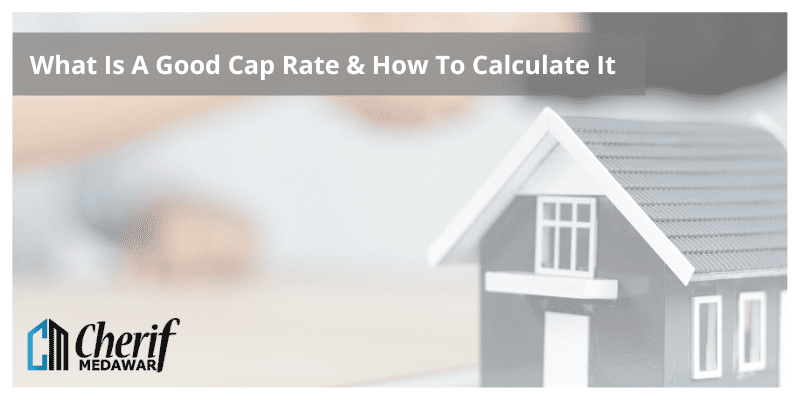What Is A Good Cap Rate & How To Calculate It
Cap rate is a useful metric used to value commercial real estate properties. Often considered a benchmark in the industry, cap rates are more commonly utilized in regards to income producing properties as they are a key indicator of future cash flow. Finding the cap rate of a property is critical to determining its value. Ideally, you want to make sure the price you pay for a property is less than the combination of rents and capital expenditures when calculated as a percentage of the property’s value. This is where cap rate comes in. Cap rate can be defined in numerous ways including: (1) net operating income divided by cost or market value; (2) gross income divided by cost; or (3) cost divided by net operating income. What Is Cap Rate? Cap rate is a real estate term that refers to the ratio of the net operating income (NOI) generated by a particular property to the property’s sales price. Cap rates are used by investors as one indication of how desirable a particular property may be as an investment. There are two parts to a cap rate: capitalization rate and value. The cap rate is a useful metric for real estate investors looking to evaluate their existing or potential investments, because it gives an indication of how well that property will generate cash flow. It does not take into account other factors like cash-on-cash return and loan payments, but these can be calculated as well to give a complete picture of your investment. A high cap rate (10%+) indicates that your investment has a low risk of default, while a low cap rate (5% or less) indicates that the property could be at a higher risk of default. Cap rates are commonly quoted as annual figures; however, they can also be calculated on a monthly basis. To convert an annual cap rate to a monthly cap rate, divide by 12. For example, if you have an annual cap rate of 8%, then your monthly cap rate would be 0.67%. What Is A Good Cap Rate For Rental Property? A good cap rate for rental property is largely determined by the location of the property and the condition of the market. The return on a real estate investment depends on how much capital you’re willing to invest, what kind of property you’re buying, and how much risk you are prepared to take. A cap rate is a simple way to estimate the potential return on an investment. It measures the ratio between annual net operating income and purchase price or current market value. A cap rate of 8 percent means that an investor would receive $80,000 in rent annually if they bought a property for $1 million dollars and collected 100 percent of their rent. It’s important to remember that there are expenses related to owning rental properties — including maintenance costs — so it’s not as simple as dividing the monthly rent by the purchase price. You’ll also need to factor in any maintenance costs and other expenses such as utilities and property taxes. The formula for the cap rate is: Cap Rate = Net Operating Income (NOI) / Current Market Value (CMV) For example, say an investment property has a current market value of $500,000 and is expected to generate $40,000 in net operating income after expenses. Using the above formula we compute: Cap Rate = 40,000 / 500,000 = 0.08 or 8% The cap rate formula is as follows: (Net Operating Income / Purchase Price) x 100 = Cap Rate in percentage form A cap rate of 10% indicates that the property generates $10,000 per year for every $100,000 in price. Put another way, it would take 10 years for a property to pay for itself if you use only income to finance the purchase. When Is Cap Rate Used And Why Is Cap Rate So Important? Cap rate is used when estimating the investment value of a real estate property. This figure tells you how much money you will earn each year on your investment without taking into account interest, taxes, etc., and is calculated by dividing the net operating income of a property by its market value. The higher the cap rate, the greater the potential return on your investment. Cap rate is one of the most important metrics for real estate investors because it gives an estimate of how much cash flow a property will generate based on its current market price. When evaluating a property, it’s important to look at the cap rate based on pro forma projections – what you expect the property will return for you once you acquire it, renovate it and fill it up with tenants – as well as the actual returns over time. In practice, cap rate is often used in place of cash on cash return, which is net operating income (NOI) divided by total cash invested. In addition to the capitalization rate, factors that affect the cash on cash return include: Total investment costs Loan size and interest rate Mortgage amortization period Recurring expenses How To Calculate Cap Rate: Capitalization Rate Formula The capitalization rate formula is calculated by dividing the net operating income (NOI) by the cost of the asset. So if an apartment building was purchased for $1,000,000 and it generates annual net operating income of $100,000 then the cap rate would be 10%. When using this formula you are assuming that the NOI will continue indefinitely at the same level and that there will be no further investment in the property after purchase. Cap Rate = Net Operating Income / Current Market Value or Cost of Real Estate Cap Rate Vs ROI A cap rate is an estimate of the potential profit per unit of a property. It’s calculated by dividing total gross income by total cost, and then subtracting all expenses, including vacancies and interest. ROI, alternatively, is the annual return on investment. While cap rate is used to determine the … Read more


